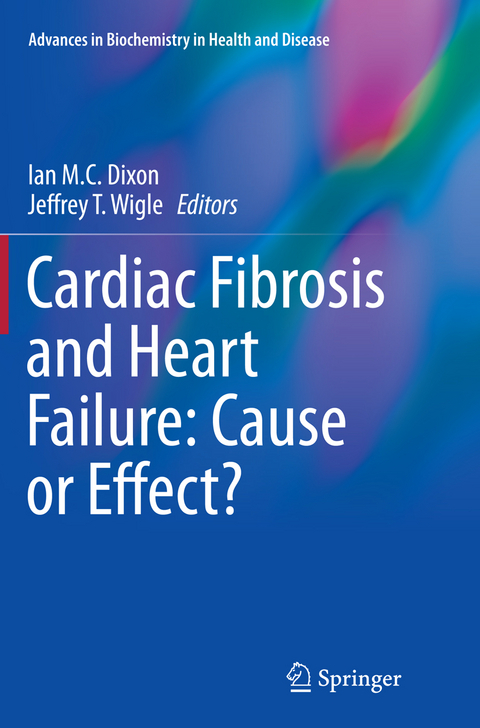
Cardiac Fibrosis and Heart Failure: Cause or Effect?
Springer International Publishing (Verlag)
978-3-319-37995-1 (ISBN)
The unique biology of cardiac fibroblasts and related cells, such as cardiac myofibroblasts and valvular interstitial cells, distinguish them from other fibroblastic cells, a concept that is only beginning to be widely appreciated. Further, the natural signals that stimulate and inhibit cardiac fibrosis within these cells are not well understood. This volume compiles articles that address the molecular mechanisms that control the synthesis and secretion of the cardiac ECM. The book showcases chapters that highlight discussion of role of Transforming Growth Factor beta (TGFbeta), an important fibrogenic cytokine and its downstream effectors SMAD in many cardiac diseases. Further, the contributions highlight information to discuss endogenous inhibitors of cardiac fibrosis, as well as advances in tissue engineering specific to matrix in the heart. Finally, discussions of unifying mechanisms of matrix remodeling in valves and myocardium are presented.
The mechanisms involved in the stimulation of cardiac fibrosis are not fully understood. In most cases the marginal attenuation of cardiac fibrosis as a result of a given therapy is a beneficial side-effect linked to other primary effects on other cells, especially cardiomyocytes. Very few drugs or agents are known to affect the function and dysfunction of cardiac fibroblasts and myofibroblasts alone. The book helps to translate the information gathered within to allow us to alter the course of fibrogenic events that are typical of cardiac fibrosis, and thereby reduce their burden on the patient and on society itself.
Dr. Jeffrey Wigle is an Associate Professor at the University of Manitoba, Winnipeg, Canada. His research focuses on the transcriptional pathways involved in regulating the growth and development of the cardiovascular system. He has characterized a number of transcription factors that are critical for the development of the lymphatic vasculature and the phenoconversion of fibroblasts to myofibroblasts. He is currently studying the transcriptional feedback loops that determine the fibroblastic phenotype. Dr. Ian M.C. Dixon is a Professor of Physiology and Pathophysiology at the University of Manitoba, Winnipeg, Canada. His research addresses heart failure following myocardial infarction and the contributing role of dysfunctional extracellular matrix in these hearts. He is also interested in mechanisms of fibroblast phenotype regulation, cardiac fibroblast SMAD protein signaling as well as other signaling proteins that may oppose the fibrogenic influence of TGF-b1 in health and disease. He has been engaged over the past 24 years in multidisciplinary research in cardiovascular matrix biology.
1. Fibrosis and Heart Failure - Cause or Effect?.- 2. Fibroblast Activation in the Infarcted Myocardium.- 3. Mechanical and Matrix Regulation of Valvular Fibrosis.- 4. Bone Marrow-Derived Progenitor Cells, micro-RNA and Fibrosis.- 5. The Stressful Life of Cardiac Myofibroblasts.- 6. Pathogenic Origins of Fibrosis in the Hypertensive Heart Disease that Accompanies Aldosteronism.- 7. Embryological origin of valve progenitor cells.- 8. Diverse cellular origins of cardiac fibroblasts.- 9. Non-Canonical Regulation of TGF-beta1 Signaling: A Role for Ski/Sno and YAP/TAZ.- 10. Molecular mechanisms of smooth muscle and fibroblast phenotype conversions in the failing heart.- 11. Current and future strategies for the diagnosis and treatment of cardiac fibrosis.- 12. Remodelling of the cardiac extracellular matrix: Role of collagen degradation and accumulation in pathogenesis of heart failure.- 13. Matrix Metalloproteinase 9 (MMP-9): The Middle-Man of Post Myocardial Infarction Extracellular Matrix Remodelling.- 14. Collagen processing and its role in Fibrosis.- 15. Mechanisms of Cardiac Fibrosis.- 16. Mathematical Simulations of Sphingosine-1-Phosphate Actions on Mammalian Ventricular Myofibroblasts and Myocytes.- 17. Extracellular Matrix and Cardiac Disease: Surgical and Scientific Perspectives.- 18. The Role of Neurohumoral Activation in Cardiac Fibrosis and Heart Failure.- 19. Natriuretic peptides: critical regulators of cardiac fibroblasts and the extracellular matrix in the heart.- 20. Cardiac Tissue Engineering for the Treatment of Heart Failure Post-Infarction.- 21. Mechanisms of Cardiac Valve Failure and the Development of Tissue Engineered Heart Valves.
| Erscheinungsdatum | 21.11.2016 |
|---|---|
| Reihe/Serie | Advances in Biochemistry in Health and Disease |
| Zusatzinfo | XV, 436 p. 73 illus., 59 illus. in color. |
| Verlagsort | Cham |
| Sprache | englisch |
| Maße | 155 x 235 mm |
| Gewicht | 688 g |
| Themenwelt | Medizinische Fachgebiete ► Innere Medizin ► Kardiologie / Angiologie |
| Naturwissenschaften ► Biologie ► Allgemeines / Lexika | |
| Naturwissenschaften ► Biologie ► Genetik / Molekularbiologie | |
| Naturwissenschaften ► Biologie ► Mikrobiologie / Immunologie | |
| Naturwissenschaften ► Biologie ► Zellbiologie | |
| Schlagworte | cardiac extracellular matrix • cardiac fibroblasts • Cardiac Fibrosis • MicroRNAs • Myofibroblasts |
| ISBN-10 | 3-319-37995-X / 331937995X |
| ISBN-13 | 978-3-319-37995-1 / 9783319379951 |
| Zustand | Neuware |
| Haben Sie eine Frage zum Produkt? |
aus dem Bereich


